- 您現(xiàn)在的位置:買賣IC網(wǎng) > PDF目錄98254 > TLV320AIC33IZQE (TEXAS INSTRUMENTS INC) SPECIALTY CONSUMER CIRCUIT, PBGA80 PDF資料下載
參數(shù)資料
| 型號: | TLV320AIC33IZQE |
| 廠商: | TEXAS INSTRUMENTS INC |
| 元件分類: | 消費家電 |
| 英文描述: | SPECIALTY CONSUMER CIRCUIT, PBGA80 |
| 封裝: | 5 X 5 MM, ROHS COMPLIANT, PLASTIC, VFBGA-80 |
| 文件頁數(shù): | 27/93頁 |
| 文件大?。?/td> | 1427K |
| 代理商: | TLV320AIC33IZQE |
第1頁第2頁第3頁第4頁第5頁第6頁第7頁第8頁第9頁第10頁第11頁第12頁第13頁第14頁第15頁第16頁第17頁第18頁第19頁第20頁第21頁第22頁第23頁第24頁第25頁第26頁當(dāng)前第27頁第28頁第29頁第30頁第31頁第32頁第33頁第34頁第35頁第36頁第37頁第38頁第39頁第40頁第41頁第42頁第43頁第44頁第45頁第46頁第47頁第48頁第49頁第50頁第51頁第52頁第53頁第54頁第55頁第56頁第57頁第58頁第59頁第60頁第61頁第62頁第63頁第64頁第65頁第66頁第67頁第68頁第69頁第70頁第71頁第72頁第73頁第74頁第75頁第76頁第77頁第78頁第79頁第80頁第81頁第82頁第83頁第84頁第85頁第86頁第87頁第88頁第89頁第90頁第91頁第92頁第93頁

DIGITAL AUDIO PROCESSING
H(z) +
N0 ) N1
z*1
32768 * D1
z*1
(1)
N0 ) 2
N1
z*1 ) N2
z*2
32768 * 2
D1
z*1 * D2
z*2
N3 ) 2
N4
z*1 ) N5
z*2
32768 * 2
D4
z*1 * D5
z*2
(2)
LB1
LB2
RB1
RB2
www.ti.com ........................................................................................................................................... SLAS480B – JANUARY 2006 – REVISED DECEMBER 2008
The DAC channel consists of optional filters for de-emphasis and bass, treble, midrange level adjustment,
speaker equalization, and 3-D effects processing. The de-emphasis function is implemented by a programmable
digital filter block with fully programmable coefficients (see Page-1/Reg-21-26 for left channel, Page-1/Reg-47-52
for right channel). If de-emphasis is not required in a particular application, this programmable filter block can be
used for some other purpose. The de-emphasis filter transfer function is given by:
where the N0, N1, and D1 coefficients are fully programmable individually for each channel. The coefficients that
should be loaded to implement standard de-emphasis filters are given in Table 1.
Table 1. De-Emphasis Coefficients for Common Audio Sampling Rates
SAMPLING FREQUENCY
N0
N1
D1
32-kHz
16950
–1220
17037
44.1-kHz
15091
–2877
20555
48-kHz(1)
14677
–3283
21374
(1)
Default de-emphasis coefficients.
In addition to the de-emphasis filter block, the DAC digital effects processing includes a fourth order digital IIR
filter with programmable coefficients (one set per channel). This filter is implemented as cascade of two biquad
sections with frequency response given by:
The N and D coefficients are fully programmable, and the entire filter can be enabled or bypassed. The structure
of the filtering when configured for independent channel processing is shown below in Figure 29, with LB1
corresponding to the first left-channel biquad filter using coefficients N0, N1, N2, D1, and D2. LB2 similarly
corresponds to the second left-channel biquad filter using coefficients N3, N4, N5, D4, and D5. The RB1 and
RB2 filters refer to the first and second right-channel biquad filters, respectively.
Figure 29. Structure of the Digital Effects Processing for Independent Channel Processing
Copyright 2006–2008, Texas Instruments Incorporated
33
Product Folder Link(s): TLV320AIC33
相關(guān)PDF資料 |
PDF描述 |
|---|---|
| TLV320AIC33IRGZT | SPECIALTY CONSUMER CIRCUIT, PQCC48 |
| TLV320AIC33IRGZRG4 | SPECIALTY CONSUMER CIRCUIT, PQCC48 |
| TLV320AIC33IRGZTG4 | SPECIALTY CONSUMER CIRCUIT, PQCC48 |
| TLV320AIC33IRGZ | SPECIALTY CONSUMER CIRCUIT, PQCC48 |
| TLV320AIC36IZQER | SPECIALTY CONSUMER CIRCUIT, PBGA80 |
相關(guān)代理商/技術(shù)參數(shù) |
參數(shù)描述 |
|---|---|
| TLV320AIC33IZQE | 制造商:Texas Instruments 功能描述:AUDIO CODEC IC ((NW)) |
| TLV320AIC33IZQER | 功能描述:接口—CODEC Lo-Pwr Stereo Codec w/6 Inp 7 Otp RoHS:否 制造商:Texas Instruments 類型: 分辨率: 轉(zhuǎn)換速率:48 kSPs 接口類型:I2C ADC 數(shù)量:2 DAC 數(shù)量:4 工作電源電壓:1.8 V, 2.1 V, 2.3 V to 5.5 V 最大工作溫度:+ 85 C 安裝風(fēng)格:SMD/SMT 封裝 / 箱體:DSBGA-81 封裝:Reel |
| TLV320AIC33NIZQE | 制造商:Texas Instruments 功能描述: |
| TLV320AIC33NIZQER | 制造商:Texas Instruments 功能描述: |
| TLV320AIC33RHBRG4 | 制造商:Texas Instruments 功能描述:CODEC - Tape and Reel |
發(fā)布緊急采購,3分鐘左右您將得到回復(fù)。